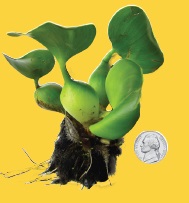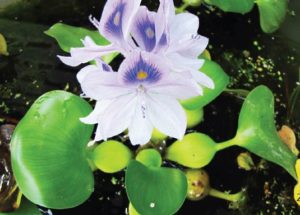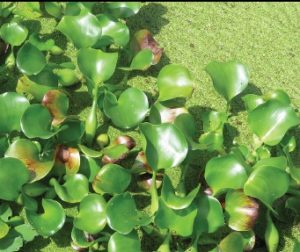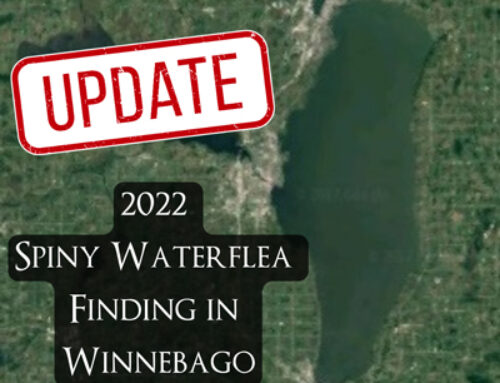Every month, we will put a spotlight on an aquatic invasive species (AIS) in a re-occurring monthly article. Check it out! This month, we highlight a plant that keeps popping up in Winneconne and was recently found near Green Bay – water hyacinth!
Water Hyacinth (Eichhornia crassipes)
Water hyacinth (Eichhornia crassipes) is a free-floating perennial plant that is native to South America. This plant has thick, green, waxy leaves that are attached to an inflated petiole that helps keep the plant afloat and upright. The roots hang below the plant in the water. When flowering, the flowers are lavender in color and have a yellow spot in a larger blue-purple blotch on the petal. Water hyacinth (WH) reproduces very quickly (doubling in as little as 6 days) and forms large, dense mats that can interfere with boating, swimming, and other waterway uses. These mats can quickly reduce the dissolved oxygen in the water which affects underwater animals such as fish. Since the mats can grow very large, very little sunlight can reach the bottom of the lake or stream, potentially leading to a reduction of native plant growth. The seeds that are produced by the plant can also lay dormant for 15-20 years and still successfully germinate. Since the plant free floats, it can spread to new locations easily by water flow and wind.
in color and have a yellow spot in a larger blue-purple blotch on the petal. Water hyacinth (WH) reproduces very quickly (doubling in as little as 6 days) and forms large, dense mats that can interfere with boating, swimming, and other waterway uses. These mats can quickly reduce the dissolved oxygen in the water which affects underwater animals such as fish. Since the mats can grow very large, very little sunlight can reach the bottom of the lake or stream, potentially leading to a reduction of native plant growth. The seeds that are produced by the plant can also lay dormant for 15-20 years and still successfully germinate. Since the plant free floats, it can spread to new locations easily by water flow and wind.
Due to its unique shape and colorful flowers, WH was originally brought to the United States for the World’s Industrial and Cotton  Centennial Exposition of 1884-1885 in Louisiana—a.k.a. the 1884 World’s Fair in New Orleans. At the Fair, the plant was given away to visitors. One visitor returned home to Florida and put her new WH in her fish pond. Soon the plant choked her pond and so she removed some of the plants and put them in the nearby St. John’s River. A New Zealand newspaper later reported that, “A field of it completely covers the water, and no steamboat can penetrate it beyond a short distance.” From there, the plant very quickly spread to neighboring southern states. By 1910, WH was choking many major waterways and efforts to eradicate the plant—including one attempt by the US War Department to pour oil directly on the plant—were not working.
Centennial Exposition of 1884-1885 in Louisiana—a.k.a. the 1884 World’s Fair in New Orleans. At the Fair, the plant was given away to visitors. One visitor returned home to Florida and put her new WH in her fish pond. Soon the plant choked her pond and so she removed some of the plants and put them in the nearby St. John’s River. A New Zealand newspaper later reported that, “A field of it completely covers the water, and no steamboat can penetrate it beyond a short distance.” From there, the plant very quickly spread to neighboring southern states. By 1910, WH was choking many major waterways and efforts to eradicate the plant—including one attempt by the US War Department to pour oil directly on the plant—were not working.
While WH continues to choke southern United States waterways, the plant has continued to invade the United States including Wisconsin. The species was a popular ornamental plant in water gardens and ponds before being listed as a Prohibited species under NR40 in 2015. However, WH plants have still been  found in local waterways in eight Wisconsin counties, including in Lake Winneconne and the Fox River in Green Bay. While removal efforts every year have worked to stop the plant from becoming established in LakeWinneconne, there is concern that WH may be able to establish a self-sustaining population due to its ability to produce seeds. While current scientific information suggests that it is unlikely that WH plants can vegetatively over-winter in Wisconsin, there is still a potential risk of fragments and/or seeds surviving and germinating the next year. Due to repeated monitoring trips with no plants found during the summer, it is hypothesized that the plant may be repetitively illegally released into Lake Winneconne near the end of the growing season (September-October). Another hypothesis is that water hyacinth is re-emerging on its own through either seed or rootstock from hyacinth plants illegally released into Lake Winneconne in the past. The time it takes for water hyacinth plants to grow from seed/rootstock to adult plants might be highly delayed or sporadic in the northerly Midwest climate of the Winnebago System compared to the plants’ native habitat of South America. This delayed time to reach maturity may account for why plants are found at the end of the growing season but not during the summer.
found in local waterways in eight Wisconsin counties, including in Lake Winneconne and the Fox River in Green Bay. While removal efforts every year have worked to stop the plant from becoming established in LakeWinneconne, there is concern that WH may be able to establish a self-sustaining population due to its ability to produce seeds. While current scientific information suggests that it is unlikely that WH plants can vegetatively over-winter in Wisconsin, there is still a potential risk of fragments and/or seeds surviving and germinating the next year. Due to repeated monitoring trips with no plants found during the summer, it is hypothesized that the plant may be repetitively illegally released into Lake Winneconne near the end of the growing season (September-October). Another hypothesis is that water hyacinth is re-emerging on its own through either seed or rootstock from hyacinth plants illegally released into Lake Winneconne in the past. The time it takes for water hyacinth plants to grow from seed/rootstock to adult plants might be highly delayed or sporadic in the northerly Midwest climate of the Winnebago System compared to the plants’ native habitat of South America. This delayed time to reach maturity may account for why plants are found at the end of the growing season but not during the summer.
Water hyacinth is classified as a Prohibited species in all counties across Wisconsin.
Want to help? HELP PREVENT THE SPREAD!
Every time you come off the water, make sure to follow these steps to stop the spread of faucet snails and other aquatic invasive species:
* Inspect boats, trailers, push poles, anchors, and other equipment for attached aquatic plants or animals. 
* Remove all attached plants or animals
* Drain all water from boats, motors, livewells and other equipment
* Never move live fish away from a waterbody
* Never release aquarium plants or animals into your local waterways
Follow the Fox Wolf Watershed Alliance’s Winnebago Waterways Program on our Winnebago Waterways Facebook page or @WinnWaterways on Twitter! You can also sign-up for email updates at WinnebagoWaterways.org.
Questions? Comments? Contact Chris Acy, the AIS Coordinator for the Winnebago Waterways Program covering Fond du Lac, Calumet, and Winnebago Counties at (920) 460-3674 or chris@fwwa.org!
Winnebago Waterways is a Fox-Wolf Watershed Alliance program. The Fox-Wolf Watershed Alliance is an independent nonprofit organization that identifies and advocates effective policies and actions that protect, restore, and sustain water resources in the Fox-Wolf River Basin.





